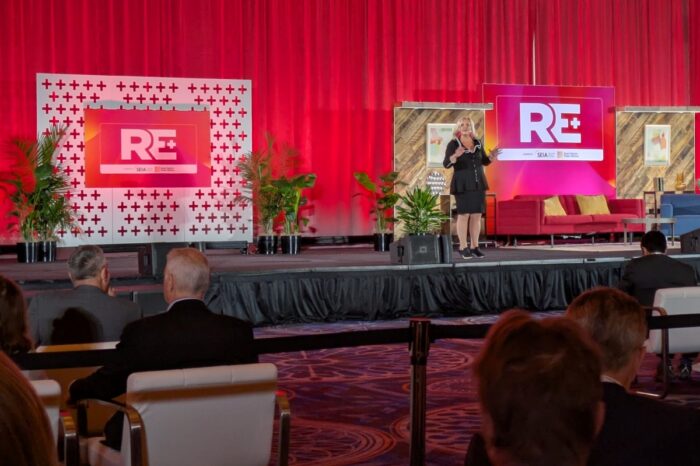Unstoppable: Amid challenges solar industry stands in defiance

It’s no secret that the solar industry has faced headwinds this year amid increasing tariffs and the rolling back of beneficial tax incentives. However, solar industry professionals remain positive despite the difficulties.
At RE+ 2025 last week, Solar Energy Industries Association (SEIA) CEO Abigail Ross Hopper walked on stage for the opening general session on Monday to Sia’s defiant anthem, “Unstoppable,” a clear signal to the more than 35,000 attendees that solar isn’t going anywhere.
Hopper described 2025 as “one of the most challenging periods of our industry’s history” as she addressed crowd.
“We took a big hit over this summer,” she said. “I’m just going to be honest. I’m going to address it right up front. We took a big hit over the summer, the federal reconciliation bill that Congress passed in early July, the bill that so many of us poured our hearts and our passion and our time and our resources into, it fell short.”
Hopper said the bill “did lasting, real damage” to many people and businesses within the industry, as projects have been delayed and jobs have been lost.
“We fought together with you, tooth and nail on this bill, side by side,” Hopper said. “And thanks to your advocacy, to your presence and to your perseverance, you did prevent a worst-case scenario. While that may not be the outcome we wanted, that outcome matters. That outcome was hard fought and worth honoring. While we worked every possible angle to influence the outcome, I know so many of you are still picking up the pieces. But make no mistake, this is not the end of our story, because we are a mature, resilient industry, and we will not back down in the face of adversity.”
Hopper said it was time for the solar industry to “pivot with purpose” to address the new regulatory and political landscape.
“Let me be clear, the people in power right now are openly hostile to our industry,” Hopper said. “They’re using every tool at their disposal to slow us down. We have faced a regulatory onslaught since the reconciliation bill happened. This administration continues to saddle solar and storage projects with delays, costs and uncertainty at a time when energy prices are rising, when global energy systems are under stress and when we need more power, not less. They’re making it harder for each and every one of you to do your job.
“The challenges are real, you guys. I know the challenges are real. I know the frustration is real and the frustration is justified, but I will be just as clear about something else. It will not succeed,” Hopper added. “Because this is not just about energy policy. It’s about the power of the market vs. the weight of policymaking. Right now, those two forces are advanced. In the face of all of these challenges and setbacks, our industry will not retreat.
“We are here, a $70 billion economic engine that employs 280,000 Americans and delivers reliable, low-cost power to every home and business in this country. We are building more power than any other electricity source combined. This demand explodes from AI data centers, from EVs and from electrification. We are delivering power faster and cheaper than any other technology. And that, my friends, is our secret sauce.”
Four point agenda for solar’s pivot
Hopper laid out a four-point agenda for the solar industry to wield its secret sauce as it pivots with purpose:
- Put storage at the center: “Storage is no longer kind of a sidekick to solar. It is core to what we offer and who we are as an industry.”
- Double down on local and state advocacy: “If we are smart and strategic, states have the power to open markets. They have the power to expedite permitting. They have the power to give companies the certainty that they need to invest.”
- Continue reshoring the solar and storage supply chain: “We’re now the third largest solar manufacturing economy in the world, not by accident but because we made a decision to pivot in the right direction, and now it’s time to dial that up. It’s time to invest in a circular economy that reduces waste and keeps more of the economic value of energy right here at home.”
- Reimagine the residential solar experience: “We cannot allow outdated business models and clunky customer experiences to be the reason that this market slows down. We have to focus on cost reduction. We need faster installs. We have to have easier permitting and seamless integration with storage.”
RE+ vibe check
Two days later, during a press roundtable discussion, Hopper asked for a “vibe check.” What were the people we talked to saying about business today and in the future? I spoke to a half dozen large-scale solar developers, financiers and EPCs throughout the conference and discovered they were surprisingly upbeat.
Solar Builder will be featuring many of the responses I gathered at RE+ in our Q4 issue as part of a project development roundtable, but let me give you a snapshot of the comments I heard.
Nick Sangermano, president of GS Power Partners, described the market outlook as a “big opportunity ahead,” adding that the regulatory changes — specifically the project start date definition — provided “a kick in the butt” to find ways to be more efficient in project development to the point that GS Power has “narrowed the time between getting development complete and actually breaking ground.”
Julia Bell, chief investment officer at CleanCapital, said that companies will be rushing to meet the July 4, 2026, deadline to start projects and safe harbor their investment, which will help prop up the industry. “I think it’s a real boost on manufacturing, both here and elsewhere, in terms of everybody wants a lot of equipment,” she said. “I think it may drive up the labor costs just because we’re now all on the same timeline.”
Sabah Bayatli, president of OCI Energy, said that the huge power demand from data centers will prevent the market from trending down. “I really don’t see anything going down,” he said. “I think what will happen is people will focus completely on projects that can meet the finish line within those four years. So, I really don’t see it down. I really see the opposite.”
Seth Adams, senior VP of EPC at Standard Solar, described the outlook for solar development as “very positive” going forward. “Obviously, there was this period this year where everyone was a bit nervous,” he said. “Things you definitely could see were on hold, everybody sort of waiting to feel things out from a political standpoint. But I think ultimately what has transpired has led to people starting to be more innovative, thinking differently.”
In addition to building new projects, Cameron Garner, section manager of project planning at Burns & McDonnell, sees increasing opportunities in maintenance and repowering existing solar projects to improve performance on older facilities.
Although federal regulatory policy seems aimed at slowing down the solar market, the industry itself isn’t stopping anytime soon.




